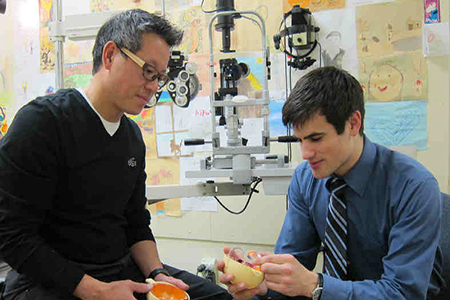In a generation of students where mathematics science and finance seem to be promoted questions arise. Are there funds for fine arts and design majors? Will artists find jobs after college? And what approach should young creative minds take to begin their college educations?
Fortunately there is always a desire for the arts and a need for creative professionals.Young adults now are ingeniously combining art with science urban development technology and environmentalism. Fine arts are varied and creative—from “classical” or traditional emphases (painting sculpting music photography) to “applied arts” (Web industrial and commercial design). Fresh concepts and products are sprouting across the nation and over the Internet. It’s only the tip of the iceberg.
Traditional fine arts live on
Institutions like Maryland Institute College of Art (MICA) emphasize a strong foundation in the classical arts—painting drawing and sculpting. Kristopher Jones admissions counselor at Kendall College of Art and Design of Ferris State University (Mich.) speaks encouragingly about drawing: “I think there is a renaissance in contemporary drawing. Drawing is again [being] given equal respect and representation as other mediums.” Certainly there can be no digitized replacement for the representation of ideas in 2- or 3-dimensional form. But if art appreciation is more your speed college programs offer degrees in art criticism the practice of evaluating and discussing art. Or study art history and fuse a love of history with a love of art—it’s like being an archaeologist of brushstrokes rather than bones.
Computer-based design
Art students these days can be found in front of easels on stages … and in front of computers. Artists are venturing into dynamic programs like graphic design animation motion graphics and video production. A growing field is interactive design: students work with various interactive media like video-game design room installations and different Web or user interface designs for phones and computer screens. Scientists it seems can also be artists—and vice versa.
Ecodesign
Ever heard of a sitting chair constructed out of cardboard? You can find students building furniture out of recycled material and found objects at schools across the country. At Parsons New School for Design a plethora of sustainably minded degrees (e.g. urban design and social innovation) are housed in the School of Design Strategies. MICA offers a studio concentration in sustainability and social engagement. Environmental and product design programs keep expanding in response to concerns over sustainability material usage and design innovation.
Industrial design
A popular definition of design is “the process of taking something from its existing state and moving it to a preferred state.” From the simplicity of the iPod and iPad and the plump goofiness of the hamburger phone to the curves of an electric guitar body and the vibrant colors of a sleek bicycle frame industrial design is everywhere. The best industrial designers take a normal product (a bottle a car) and come up with an original concept for it (a Coke bottle a Volkswagen Beetle). To give you an idea Starbucks recently sponsored the Betacup disposable coffee cup contest. Industrial designers submitted ideas for new to-go coffee cups that reduce waste and also happen to look pretty cool.
Broadening opportunities
Fine artists craft artisans and product designers have plenty of space to market themselves (thank you Internet!). Alongside traditional jobs opportunities abound for artists to sell their work online on websites like Etsy.com. Positions for art educators are also increasing according to Theresa Bedoya, vice president for admissions and financial aid at MICA: “Art and design colleges because they offer so many specialized programs of study seek professors with even deeper areas of specialty such as video and film sound art performance art and exhibition design.”
First steps
If a career in the arts fits you decide which type of school you’d like to attend in order to obtain your Bachelor of Fine Arts (BFA) degree. You can study at a specialized art school or within the art department of a traditional institution. Fine arts and design programs can also be highly competitive. Here’s what you need to know about applying.
Do your research. Check out school websites. Find out the programs and courses offered the ratio of liberal arts core courses to studio classes who the faculty members are and what connections the school has to museums galleries and design firms. Look for programs that speak to your specific interests. Investigate work by current students and how the graduates of a school have fared in obtaining art-based jobs. In addition collect art around you. Scott Ramon, director of undergraduate admissions at School of the Art Institute of Chicago (SAIC) suggests, “Subscribe to magazines like Art Forum or Juxtapoz. … Create an archive of things that you like to look at or read that may or may not be art-related.”
“Don’t be timid to do a lot of research and ask questions of anyone in the field,” says Jones. “Observe a class … take note of significant scholarship deadlines and visit during open houses and special visit days.” Visiting a school will help you tell whether it’s an aesthetic environment you want to create in and whether you appreciate the student body as well as the other facilities and resources. Molly Ryan, admissions director at CalArts stresses, “We want to determine if a student is the right fit for us is open to experimentation … and also that we are the right fit for a student—if they are interested in being part of an environment like ours.”
The application and portfolio
Colleges are looking for dedication and determination in their art and design applicants. After all art is a competitive field! Ryan says it is an advantage if a student “already has a personal interest and direction in their own work.” While transcripts recommendations and test scores are important your art portfolio is a crucial component of your application. Scott Lindzy, vice president for enrollment at Savannah College of Art and Design (SCAD) suggests, “Students should carry a sketchbook with them whenever possible and seize the opportunity to draw from observation frequently.” Then seek out a teacher or mentor who will help you put together a collection of pieces. Somewhere between 10 and 20 pieces are usually required.
Observational drawing is an important skill to exhibit. But also include pieces in your portfolio that best reflect your talents interests and versatility as an artist. Joel Towers, dean of Parsons notes, “Our students have a keen appreciation for how things appear … and an instinctive desire to improve them.” Branch out and produce a lot of work so that you have many choices for your portfolio. Jones suggests “Students are encouraged to explore within themselves their own unique view and passion of visual art.” In other words risk a little!
But don’t neglect other components of your application. Judith Aaron vice president for enrollment at Pratt Institute says, “The academic record is also important as it demonstrates the student’s work ethic and his or her ability to do well in the liberal arts.” Strong recommendations a good academic record a passionate personal statement and a sparkling interview can help you stand out in a pool of talented hopefuls.
Outside the classroom
Toy design fiber arts choreography urban planning—since art is crossing new frontiers potential artists will want to stretch themselves too. Students interested in traditional graphic design should now learn some Web design which involves an overlapping skill set. Towers points out that students should receive “a broad-based design education that allows exploration across a spectrum of disciplines.”
Many programs emphasize the importance of practical industry-related experience. Lindzy of SCAD adds, “Students should also be looking for inspiration for their art from a wide range of sources and should experiment with as many media as possible.”
Many schools also offer summer portfolio camps where high school students can build their portfolios work with fellow artists and receive critiques from college faculty. Aaron says that “students can assess the degree of their interest and commitment. … It is extremely important that students understand what it means to go to an art and design school before they begin the application process.” Bedoya notes that “MICA’s pre-college program is particularly successful in this respect because it is designed to provide in-depth investigation and skill building in a single area of art or design—this is the key to successfully preparing a strong portfolio of artwork.”
“Society becomes more and more dependent on those who reimagine the world on a daily basis,” expresses Ramon of SAIC. Bedoya puts it this way: “[Artists] challenge assumptions make connections and communicate ideas no one else could envision.” New doorways are creaking open—will you foray out into the colorful wild?
Salaries
You may be wondering how much artists designers and other creative professionals earn. Here are the mean salaries for certain careers open to graduates with fine arts and design degrees. Keep in mind that salaries vary by geographic location. Additionally as these are average salaries among all individuals in the specified field the starting salaries will typically be less.
| Art Directors: | $91,520 |
| Commercial and Industrial Designers: | $61,400 |
| Fine Artists Including Painters Sculptors and Illustrators: | $50,630 |
| Graphic Designers: | $47,820 |
| Fashion Designers: | $74,410 |
| Interior Designers: | $51,990 |
| Multi-media Artists and Animators: | $62,810 |
Jill Hicks is the online editor of My College Guide.



